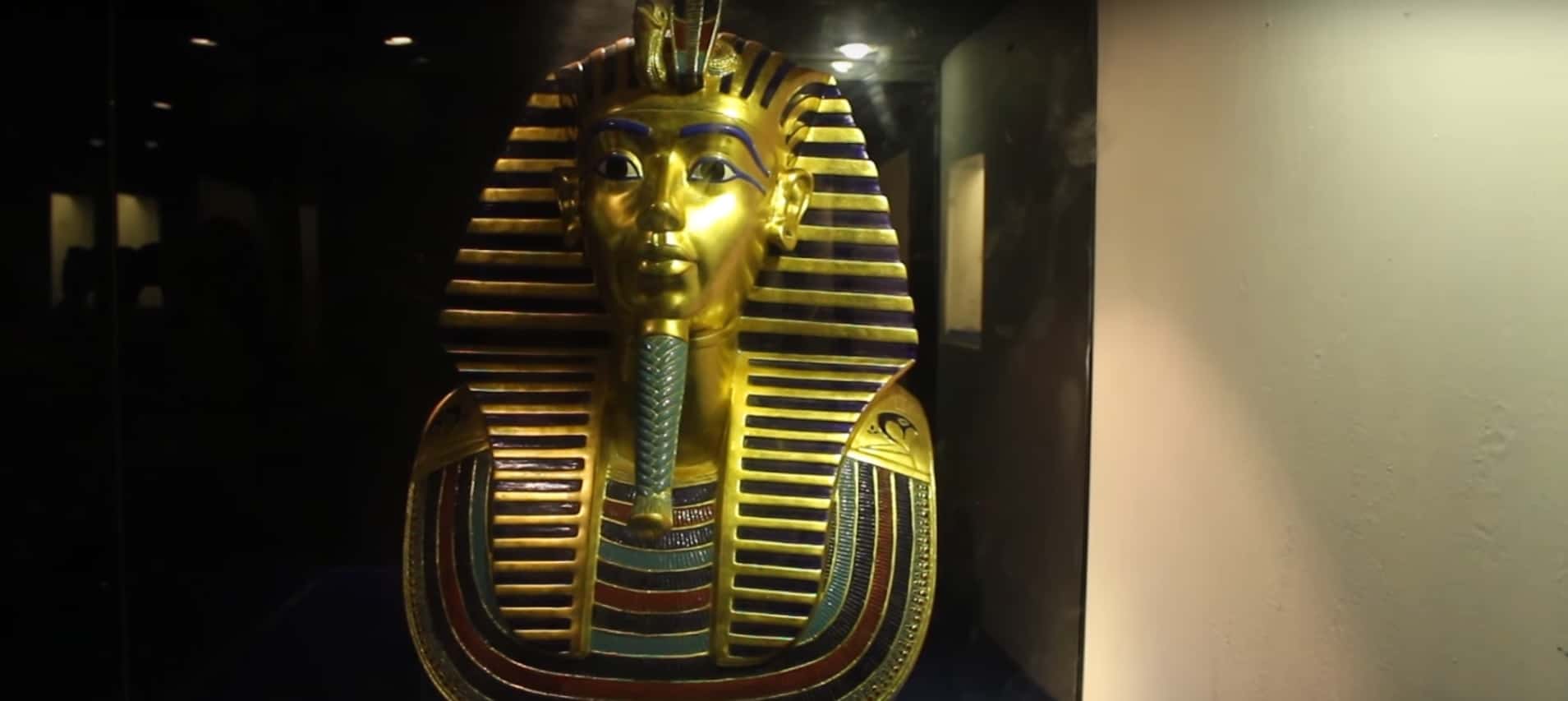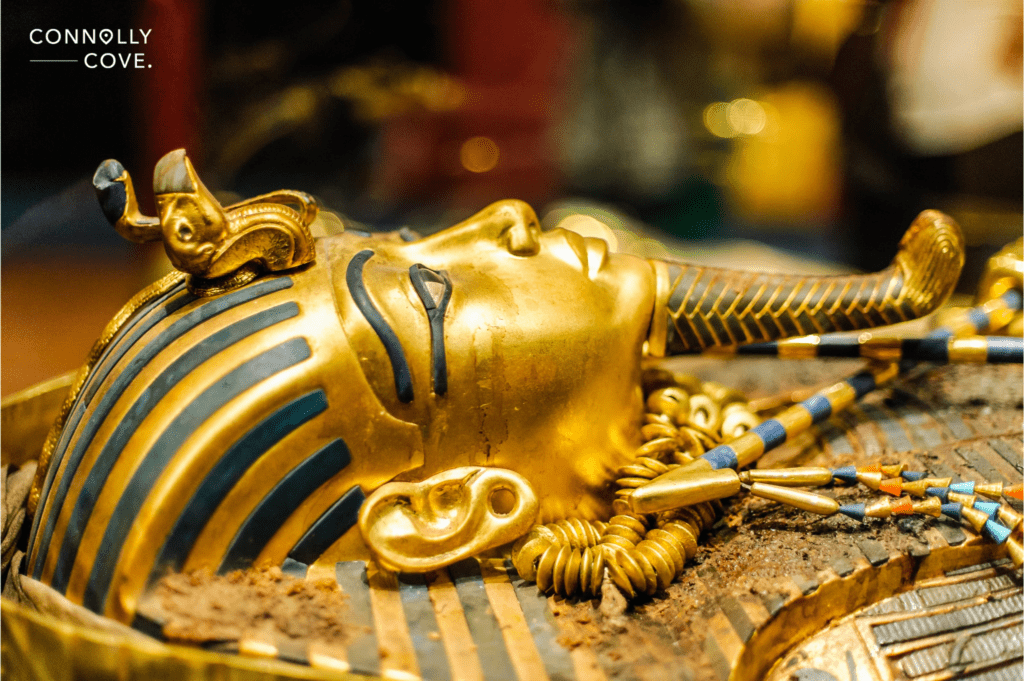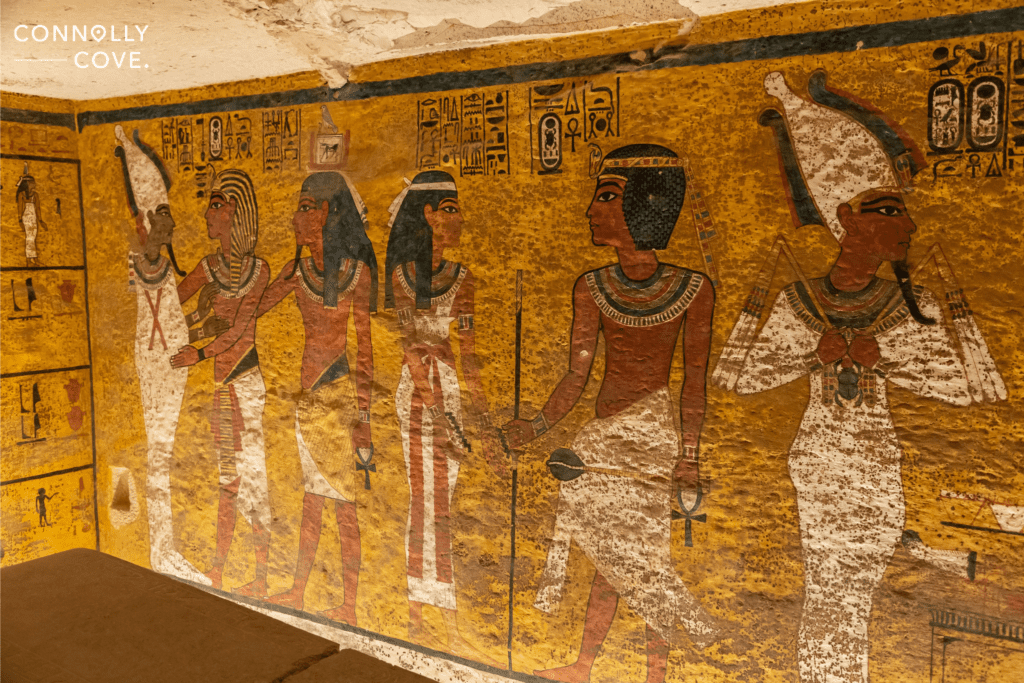King Tutankhamun’s Tomb, Cairo, Egypt

Updated On: April 07, 2024 by Asmaa Alhashimy
In the annals of human history, a treasure trove of archaeological wonders has stirred the imagination and piqued the curiosity of generations. Among these, few discoveries stand as profoundly captivating as King Tutankhamun’s tomb, which was unearthed in the Valley of the Kings near Luxor, Egypt. This remarkable find, made by British archaeologist Howard Carter in 1922, not only unveiled an ancient burial site but also revealed a time capsule of unparalleled luxury and mystique, preserved for over 3,000 years amidst the sands of the desert.
Situated on the west bank of the majestic Nile River, the tomb of the boy King Tutankhamun lies nestled within the sandstone cliffs of the barren landscape. Its discovery marked a watershed moment in the study of ancient Egypt, offering an unprecedented glimpse into the splendour and grandeur of one of the world’s most iconic civilizations. Beyond mere archaeological significance, King Tutankhamun’s tomb symbolises a gateway to the past, a portal through which we can peer into the lives and beliefs of those who walked the earth millennia before us.
The story of King Tutankhamun, also known as King Tut, is shrouded in mystery and intrigue. Ascending to the throne of Egypt at the tender age of nine, Tutankhamun’s reign during the 18th dynasty of the New Kingdom period was relatively brief, lasting only around ten years. Despite his youth, his legacy endured, albeit overshadowed by the more illustrious pharaohs of ancient Egypt. However, his tomb, discovered intact by Howard Carter and his team, would ultimately secure his place in the annals of history.
The discovery of Tutankhamun’s tomb was not merely a stroke of luck but the culmination of years of painstaking excavation and relentless determination. With the financial backing of Lord Carnarvon, Howard Carter had devoted much of his life to the exploration of the Valley of the Kings, driven by a genuine belief in an undiscovered royal burial site. His perseverance was rewarded on 4 November 1922 when he stumbled upon a step leading to the entrance of what would become one of the most extraordinary archaeological finds of all time.
On 16 February 1923, after years of anticipation and meticulous excavation, Howard Carter finally breached the sealed door to Tutankhamun’s tomb, unlocking a treasure trove that would captivate the world. What lay within those hallowed chambers would redefine our understanding of ancient Egypt and illuminate the depths of its cultural and artistic achievements. From exquisite golden artefacts to intricately carved furniture and priceless relics, the contents of King Tutankhamun’s tomb offered a rare glimpse into the opulent world of ancient royalty.
As we embark on a journey to explore the wonders of King Tutankhamun’s tomb, we are reminded of the grandeur of Egypt’s past and the enduring legacy of human ingenuity and curiosity. From the golden sands of the desert to the hallowed halls of ancient tombs, the story of King Tutankhamun continues to captivate and inspire, inviting us to unravel the mysteries of the past and discover the secrets that lie buried beneath the sands of time.
Table of Contents
History and Discovery
Tutankhamun, also known as King Tut, ascended to the throne of Egypt at the tender age of nine in approximately 1332 BCE, during the 18th dynasty of the New Kingdom period. His reign was relatively short-lived, lasting only around ten years, and his more illustrious predecessors overshadowed his significance in Egyptian history. However, his tomb would eventually secure his place in the annals of archaeology.
The story of the discovery of Tutankhamun’s tomb is as legendary as the pharaoh himself. Howard Carter, a British archaeologist, had been tirelessly excavating the Valley of the Kings for years with the financial backing of Lord Carnarvon. On 4 November 1922, Carter’s persistence paid off when he stumbled upon a step leading to the entrance of a tomb. After years of excavation and anticipation, on 16 February 1923, Carter finally opened the sealed door to the tomb’s inner chambers, revealing a treasure trove that would stun the world.
Treasures Unearthed
A treasure trove of artefacts awaited Carter and his team inside the tomb, including furniture, jewellery, chariots, weapons, and more. Among the most iconic finds were the three golden coffins nested within each other, each more intricately decorated than the last, and the solid gold death mask that adorned Tutankhamun’s mummified remains.
These artefacts’ sheer luxury and craftsmanship spoke volumes about the wealth and power of ancient Egyptian royalty. It was clear that no expense had been spared to ensure Tutankhamun’s journey into the afterlife was as grand as his earthly reign.
However, it wasn’t just the quantity and quality of the artefacts that captivated the world. It was also the mystery surrounding Tutankhamun’s relatively obscure reign and untimely death that piqued public interest. Who was this young pharaoh, and what had led to his demise at such a young age?
Unraveling the Mysteries

Tutankhamun ascended to the throne at the tender age of nine and ruled Egypt for approximately ten years during the 18th dynasty of the New Kingdom. His reign was overshadowed by the legacy of his father, Akhenaten, who had attempted to revolutionize Egyptian religion by promoting the worship of a single deity, the sun god Aten.
Some scholars believe that Tutankhamun, originally named Tutankhaten, was born to Akhenaten and one of his sisters. Upon ascending the throne, he reversed many of his father’s religious reforms, restoring the traditional polytheistic worship of the Egyptian pantheon.
However, Tutankhamun’s reign was cut short, and his death’s circumstances remain mysterious. Initial examinations of his mummified remains suggested that he may have suffered from a variety of health issues, including a foot deformity and malaria. However, recent studies have cast doubt on these findings, leading to renewed speculation about the cause of his death.
One theory posits that Tutankhamun died due to a chariot accident, while others suggest foul play, possibly involving his chief advisor, Ay, who succeeded him to the throne. However, without conclusive evidence, the exact circumstances of Tutankhamun’s death may never be known.
The Burial Chamber
Beyond the antechamber lay the heart of King Tutankhamun’s tomb — the burial chamber itself. As Carter penetrated deeper into the tomb’s inner sanctum, he encountered a sight that defied imagination — the magnificent sarcophagus of the young pharaoh. The sarcophagus housed three nested coffins carved from a single quartzite block, each intricately adorned with symbols of protection and divinity. Within the innermost coffin lay the mummified remains of King Tutankhamun, shrouded in layers of linen and decorated with priceless amulets.
The Curse of the Pharaohs
The discovery of King Tutankhamun’s tomb was not without intrigue and mystery. Legend has it that a curse befell those who dared to disturb the eternal slumber of the pharaoh, leading to a series of misfortunes and untimely deaths among the expedition members. While modern science may attribute these occurrences to natural causes and coincidence, the curse of the pharaohs continues to capture the imagination of enthusiasts and scholars alike, adding an aura of mystique to the story of King Tutankhamun.
Legacy and Impact
The discovery of King Tutankhamun’s tomb profoundly impacted our understanding of ancient Egypt and its rich cultural heritage. The treasures unearthed by Howard Carter provided scholars with invaluable insights into the ancient Egyptians’ rituals, beliefs, and daily life, shedding light on a civilization that had long captivated the human imagination.
Moreover, the global fascination with King Tutankhamun and his tomb sparked a renewed interest in Egyptology and archaeology, inspiring countless expeditions and discoveries in the following decades. Today, the tomb of King Tutankhamun remains one of the most visited and studied archaeological sites in the world, attracting millions of tourists to the Valley of the Kings each year.
Preservation and Conservation Efforts

Recently, concerns have been raised about the long-term preservation and conservation of King Tutankhamun’s tomb and its precious artefacts. The influx of tourists and exposure to the elements have taken their toll on the fragile remains, leading to deterioration and damage over time.
In response, the Egyptian government, in collaboration with international organizations and experts, has implemented various conservation measures to safeguard the tomb and its treasures for future generations. These efforts include climate control systems, protective barriers, and strict visitor regulations to minimize wear and tear on the ancient site.
Visiting King Tutankhamun’s Tomb Today
For those wishing to experience the wonder of King Tutankhamun’s tomb firsthand, visiting the Valley of the Kings is an unforgettable journey back in time. Located on the west bank of the Nile River, near Luxor, the valley is home to dozens of ancient tombs, including the boy king himself.
Visitors to the tomb of King Tutankhamun can explore its intricately decorated chambers, marvel at the golden treasures on display, and imagine the grandeur of ancient Egypt at its peak. However, due to the fragile nature of the artefacts and the ongoing conservation efforts, access to the tomb may be limited, and photography may be restricted to protect the delicate remains.
Last Words
The discovery of King Tutankhamun’s tomb stands as one of the most significant archaeological achievements of the 20th century, unlocking the mysteries of ancient Egypt and captivating the world with its treasures. From the glittering gold artefacts to the enduring legends of curses and curses, the story of King Tutankhamun continues to fascinate and inspire new generations of scholars, historians, and adventurers.
As we unravel the secrets of the past, King Tutankhamun’s tomb remains a timeless testament to the ingenuity, artistry, and enduring legacy of one of history’s most enigmatic civilizations. And while the boy king may have been lost to the sands of time, his legacy lives on in the treasures he left behind, ensuring that his name will be remembered for eternity.






